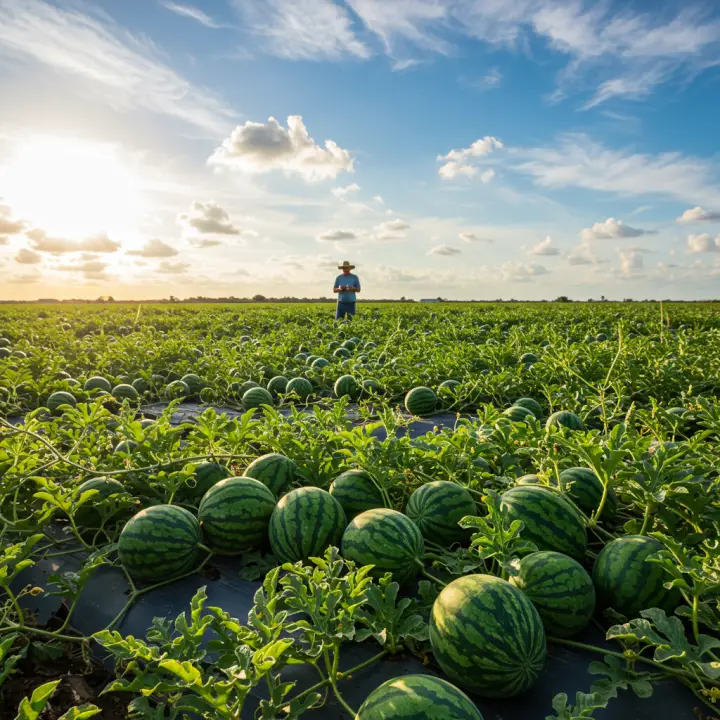Florida, with its abundant sunshine and warm climate, offers ideal conditions for growing juicy, delicious watermelons. However, timing is everything when it comes to maximizing your harvest. Understanding the best time to plant watermelon in Florida, along with the nuances of different varieties and specific regional microclimates, will set you up for sweet success. This comprehensive guide will walk you through everything you need to know, from choosing the right seeds to harvesting your prize-winning melons.

Understanding Florida’s Unique Climate Zones
Florida’s climate is classified as subtropical and tropical, but it’s important to recognize the subtle differences between North, Central, and South Florida when planning your watermelon patch.
- North Florida: Experiences milder winters and hotter, more humid summers. The first and last frost dates are more significant considerations in this region.
- Central Florida: Enjoys a longer growing season with warmer temperatures throughout the year. Frosts are less frequent and less severe.
- South Florida: Boasts a truly tropical climate with warm temperatures year-round. Frost is rare, allowing for extended growing seasons.
The Best Time to Plant Watermelon in Florida: Region by Region
The ideal planting time for watermelon in Florida depends heavily on your specific location. While the general rule is to plant after the last frost, utilizing soil temperature as a guide is even more critical. Watermelons thrive in warm soil, ideally between 70°F and 85°F.
- North Florida: Target planting between late March and early May. This allows the soil to warm sufficiently while avoiding the hottest summer months for initial growth.
- Central Florida: You have a wider window, from late February to early June. Early planting can take advantage of the extended growing season, but be prepared to protect young seedlings from unexpected cold snaps.
- South Florida: Enjoy the luxury of a near year-round growing season. You can plant watermelon from January to March for a spring harvest, and again in August for a fall harvest.
Choosing the Right Watermelon Variety for Florida
Selecting a watermelon variety suited to Florida’s climate and your desired harvest time is crucial. Consider these factors:
- Days to Maturity: This indicates the time from planting to harvest. Choose varieties with shorter maturity periods (70-80 days) if you have a shorter growing season or want a quicker harvest. Longer-maturing varieties (80-90 days) are suitable for South Florida and longer growing windows.
- Disease Resistance: Florida’s humidity can foster certain diseases. Opt for varieties resistant to common watermelon diseases like Fusarium wilt and anthracnose.
- Size and Shape: Watermelons come in various sizes, from the petite Sugar Baby to the jumbo Crimson Sweet. Consider your space and storage capabilities when making your selection.
Popular Watermelon Varieties for Florida:
- Crimson Sweet: A classic variety known for its large size, sweet flavor, and oblong shape.
- Sugar Baby: A small, round watermelon perfect for smaller gardens and quick harvests.
- Charleston Gray: An elongated, light-green watermelon resistant to sunburn and cracking.
- Jubilee: A high-yielding variety with a long shelf life and excellent disease resistance.
- Allsweet: Another large, sweet variety with good disease resistance.
Planting and Care Tips for Florida Watermelons
- Soil Preparation: Watermelons prefer well-drained sandy loam soil rich in organic matter. Amend your soil with compost or aged manure before planting.
- Planting Method: Plant seeds directly into the ground 1 inch deep and 2-3 feet apart in rows spaced 6-8 feet apart. You can also start seeds indoors 3-4 weeks before the last frost and transplant seedlings outdoors after the soil has warmed.
- Watering: Watermelons need consistent moisture, especially during fruit development. Water deeply and regularly, but avoid overwatering, which can lead to root rot.
- Fertilizing: Apply a balanced fertilizer at planting time and again when the vines begin to run. Side-dress with nitrogen-rich fertilizer when fruit begins to set.
- Pest and Disease Control: Monitor your plants for common pests like aphids and cucumber beetles. Employ preventative measures and address infestations promptly. Rotate crops annually to reduce disease incidence.
- Weed Control: Maintain a weed-free environment around your watermelon plants to minimize competition for nutrients and water. Mulching can help suppress weeds and retain soil moisture.
Harvesting Your Florida Watermelons
Knowing when to harvest your watermelons is key to enjoying peak flavor and sweetness. Look for these signs:
- Tendril Drying: The tendril closest to the fruit will start to dry up and turn brown.
- Ground Spot Yellowing: The spot where the watermelon rests on the ground will turn from white or green to a creamy yellow.
- Dull Skin: The watermelon rind will lose its glossy sheen and become dull.
- Thump Test: A ripe watermelon will emit a deep, hollow thud when thumped.
Extending the Watermelon Season in Florida
With careful planning and variety selection, you can extend your watermelon harvest in Florida. Consider successive plantings, starting new seeds every few weeks, to ensure a continuous supply of fresh melons throughout the summer. In South Florida, you can even enjoy a fall harvest by planting in late summer.
Enjoying the Fruits of Your Labor
Growing watermelons in Florida can be a rewarding experience, culminating in the sweet satisfaction of enjoying a homegrown treat. By following this guide and adapting it to your specific location and preferences, you’ll be well on your way to achieving watermelon-growing mastery in the Sunshine State. So, prepare your garden, choose your seeds, and get ready to savor the refreshing taste of summer’s quintessential fruit!

